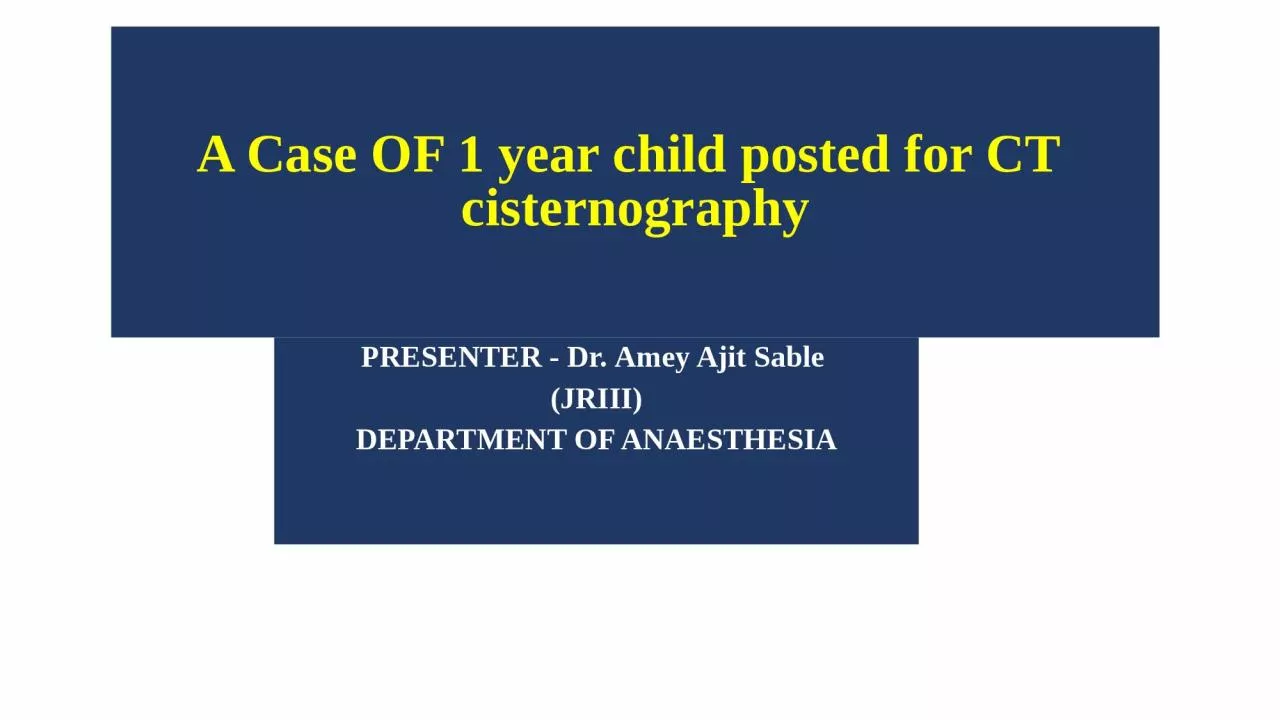

cisternography PRESENTER Dr A mey Ajit Sable JRIII DEPARTMENT OF ANAESTHESIA CHIEF COMPLAINTS Informant Mother 1 year old complaints of head injury 2 days back female child presented with chief ID: 934759
Download Presentation The PPT/PDF document "A C ase OF 1 year child posted for CT" is the property of its rightful owner. Permission is granted to download and print the materials on this web site for personal, non-commercial use only, and to display it on your personal computer provided you do not modify the materials and that you retain all copyright notices contained in the materials. By downloading content from our website, you accept the terms of this agreement.
Slide1
A Case OF 1 year child posted for CT cisternography
PRESENTER -
Dr.
A
mey
Ajit
Sable
(JRIII)
DEPARTMENT OF ANAESTHESIA
Slide2CHIEF COMPLAINTS
Informant - Mother
,1 year
old complaints of-
head injury 2 days back.
female child presented with chief
HOPI:
History of head injury two days back when baby had fall the from bed .
Slide3History of rhinorrhea since two days . No history of ENT bleed , unconsciousness. No h/o seizures, excessive crying, irritability, no muscle weaknesses.
Slide4Birth history : full term normal vaginal delivery, cried
immediately after birth , completely immunized.
Past history: not significant.
Family history : not significant.
Slide5GENERAL EXAMINATION
Female child conscious, un co-operative
Weight-
6 kg
.
Afebrile
PR-
120
min
RR- 20/min
No pallor, icterus, cyanosis, oedema or lymphadenopathy.
Slide6SYSTEMIC EXAMINATION
CVS – S1S2 normal , no murmur
RS – Air entry bilaterally equal, no abnormal sounds.
P/A – soft, bowel sounds present .
CNS - conscious
Slide7Anaesthesia ManagementBaby was NBM was since mid night confirmed with mother and consent checked.Patient taken for CT guided cistrenography .Standard anesthesia monitoring attached in the form of ECG, pulse oximeter, non-invasive blood pressure monitor.
IV fluid connected.
Slide8PROVISIONAL DIAGNOSIS
1 year child posted for CT cisternography under general
anesthesia in Radio-diagnosis department as advised by neurosurgery department.
Slide9INVESTIGATIONSHb- 10.9 g%
TLC- 5,000 / cmm
Platelets- 2.6 lakh/cmm
Blood group- B positive
RBS
98 mg %
LFT
S . bilirubin
TOTAL
0.5 mg%
DIRECT
0.3 mg %
SGPT
17 IU/L
[ 0-40 IU/L]
SGOT
8 IU/ L
[5-35 IU/L]
S.ALP92 IU/ L[15-112 IU/L]
RFTBlood urea17 mg%S. creatinine0.2 mg %
Na+ -139 m mol / LBT- 2 min , 00 secK+ - 4.8 m.mol /LCT – 4 min . 15 sec
INR1.0
PT13.6 secs
CXR- WNL
2DECHO – Normal
study
Slide10Pre-med: Inj.GLYCOPYRROLATE 0.02mg given IV, Inj.Midaz 0.12mg given IV, Inj fentanyl 10mcg given.Patient preoxygenated with 100% oxygen.
Induced with 20mg propofol IV after loss of reflexes
Immediately after bag and mask Thick white milky content seen per orally and nasally.
Laryngoscopy done and intubated with number 4.0 uncuffed tube.
Inj. atracurium 3mg given.
Slide11Infant feeding tube number(IFT) 8 inserted nasally with immediate effects.Though we are not suppose to do nasal suctioning in CSF rhinorrhoea but nasal cavity was filled so Intratubal suctioning done. Placement of the tube confirmed with auscultation. Crepts on right lung with Conducted sounds present over right lung. Suctioning done from IFT , oral and nasally.
Salbutamol puff 100ug was given.
Patient was given
Inj.Hydrocortisone
12 mg IV,
Inj
. Dexamethasone 0.6 mg IV.
Slide12Four times Intratubal suctioning was done.Crepts subsided , Conducted sounds reduced on auscultation.Maintenance on oxygen, Nitrous oxide, sevoflurane ,IPPV.Even after aspiration we continued with procedure and given baby left lateral position .Lumbar puncture was done with 26G hypodermic needle.
Iomerol
(
iodinised
non ionic low
osmolar
) contrast
3.00cc given after dilution with CSF.
After that CT cisternography was done.
Slide13Slide14Aspiration
Slide15No intraoperative hemodynamic variation or variation in saturation.Reversed with Inj.Neostigmine 0.3 mg plus Inj.glycopyrrolate 0.04mg.Eye opening present and not maintaining without Oxygen.
Slide16100% oxygen was given for 20 minutesPatient started maintaining saturation without Oxygen after 20 minutes. Endotracheal tube removed after suctioning.Patient was kept on steroids for 24 hours and on higher antibiotics.Patient kept on oxygen mask for 24 hours.
Slide17Discussion
Slide18Gastric acid aspirationOne of the most dangerous and challenging situation is while anaesthetising pediatric age group is gastric acid aspiration.fasting guidelines :
C
lear fluids : 2 hours
B
reast milk: 4 hours
I
nfant formula : 6 hours
S
olid (fatty fried food): 8 hours
Slide19Breast milk has very high variable fat content (determined by material diet) delays gastric emptying.Pre disposing factors for regurgitation aspiration Decreased competence of lower esophageal sphincter
A
ir swallowing while crying during pre induction period
Strenuous
diaphragmatic breathing.
Slide20Management of aspiration Aim is to reverse pulmonary functions and gases exchange.Oxygen face mask to maintain saturation(>96%on room air)E
ndotracheal intubation and general anaesthesia given additional sedation and muscle relaxation.
E
xamination of airway with bronchoscope and removal of solid particles.
Slide21Take home message For day care procedures we can't expect morbidity and mortality.So strict NBM guidelines should be followed.
Slide22